
Many fruits can be made into a curd. The basics of curd are fruit, sugar, an acid, eggs and or yolks and butter. For the Peach Curd, I used a dry white wine which gives a more subtle taste but lemon juice can also be used.
I was surprised that it only took 2 large peaches to make more than enough puree for the Peach Curd. Several weeks ago, I posted the Dutch Peach Pie. For that recipe, I thought that peeling the peaches was best because I didn’t want them to juice a lot. However, for this recipe, I favor removing the skins by dropping the peaches in boiling water for a few minutes until the skins slip off easily. This method slightly cooks the outside of the peach and they usually will juice more.
The crust for this Peach Curd Tart is the French Pate Sucre Crust which is a somewhat sweet crust. It is easily put together in the food processor and I prefer this method as opposed to creaming the sugar and butter in a mixer as the finished pastry stays firm. However, it does soften easily due to a large amount of butter. It is easily worked by rolling between wax paper and chilling when it becomes soft. While only ¼ inch thick after baking, this crust stayed crisp even after 4 days in the refrigerator. This is now my favorite crust for a fruit tart.
By drawing a circle on the wax paper, it is easy to roll the pastry to the correct size. Having said that I usually overshoot it slightly which is fine. It is best to have some leftover dough as the crust has a tendency to crack when fully baked. It is easy to patch when the dough comes from the oven and no one will know the difference.
After the Peach Curd has been poured into the shell, it is necessary to cover the curd by laying plastic wrap directly on top of the curd. This is a soft but stable curd as you can see. It cuts beautifully. While I didn't try it, I can't see why this tart couldn't be made in its entirety and frozen. Thaw in the refrigerator.
While I chose to pipe a lattice top on my tart, you can do whatever you want.
Pate Sucre Pastry Crust
1 ¼ cup all-purpose flour (175 grams or 6 ⅛ ounces)
½ cup unsalted butter, cold and cut into small pieces (114 grams or 4 ounces)
¼ cup granulated sugar (50 grams or 1 ¾ ounces)
2 egg yolks
Have a 9”x1” tart pan with a removable bottom available.
Place the flour in the bowl of a processor. Pulse several times. Add the cold butter and process until the butter is indistinguishable. Next, add the sugar and process briefly to mix in. Finally, add the yolks and process until the crust comes together.
Shape it into a disc about 1” thick. If it is soft, wrap it in film and place it in the refrigerator to firm up. It may also be made several days ahead. Let it sit at room temperature to soften slightly before rolling.
On a piece of wax paper at least 15” long, draw an 11” circle in the middle of the paper. I used a dinner plate the right size. 



Mark the circle lightly into the pastry with the back of a table knife through the paper.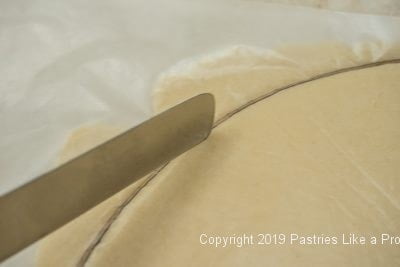
Holding the paper by the edge pastry side down, center the dough over the tin. Let it sit there for a few minutes if really cold.



Refrigerate for 30 minutes or until firm.
About halfway through chilling, preheat the oven to 375°F. Tear a piece of foil about 13 inches long and spray one side of it with a baking release. When the pastry is firm, line with the foil, spray side down. 
Bake for 25 minutes, remove the weights carefully by grasping all four corners of the foil and lifting out. Return the crust to the oven and bake for about 10 to 15 minutes more until completely baked. If the crust cracks pinch off a small piece of the reserved unbaked dough and cover the crack.
Peach Curd
Using the ingredients listed below, go here for how-to photos. Understanding Gelatin has an in-depth discussion on this subject.
1 teaspoon water
½ teaspoon gelatin
12 ounces fresh ripe peaches (340 grams or 1 ½ cups)
½ cup granulated sugar (100 grams or 3 ½ ounces)
¼ cup dry white wine or lemon juice
5 egg yolks (85 grams or 3 ounces)
1 stick unsalted butter, cold and cut into pieces (4 ounces or 114 grams)
Dissolve gelatin in the water. Set aside.
Place peaches in boiling water for several minutes until the skins will slip off easily. Run under cold water and skin peaches. Remove the pits. Puree the peaches in a blender or food processor. 
Place in the top of a double boiler. Add the butter. Place over hot water and, stirring constantly, bring to 172 degrees on a candy thermometer. Remove from over the water. Tear the gelatin, which will have become a semi-solid blob, into pieces and add it to the hot liquid. Whisk into the Peach Curd.
Immediately, pour it into the baked crust, cover directly with plastic wrap and refrigerate for about six hours or overnight until set.
Lattice Topping for the Peach Curd Tart
1 cup heavy cream
¼ to 13 powdered sugar (30 to 45 grams or 1 to 1 ½ ounces)
Place the ingredients in a mixing bowl and beat until stiff.
Fit a piping bag with a #2 open star tip and pipe straight lines across the tart about 1” apart and ½ " from the edge of the tart.

Yield: One 9” tart. Store in the refrigerator.
More summer desserts can be found here:
Sweet Cherry Calzones with Amaretti Crumble
Chocolate Raspberry Pop Tarts
Double Chocolate No Machine Ice Cream








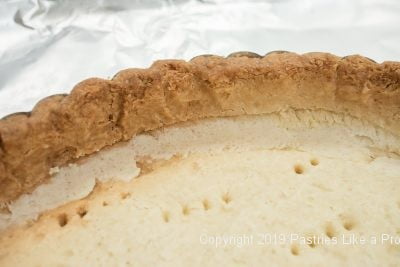
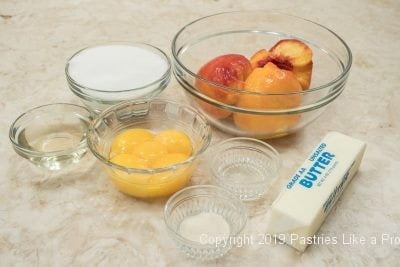








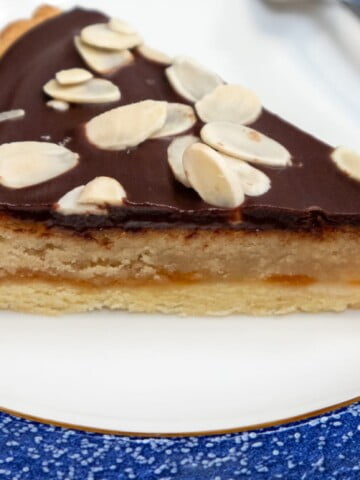
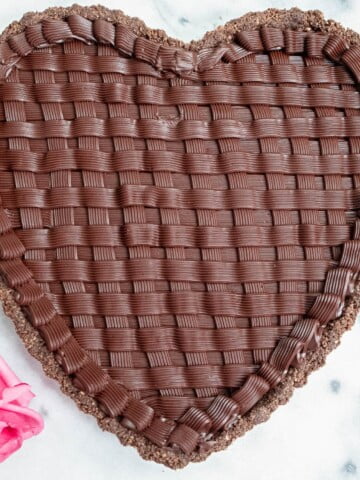
Bonnie Wilson says
You never explain what to do after putting raw dough over the cracks in crust-can’t just fill with curd & eat with raw dough on cracks can you?
Helen S Fletcher says
If you put a thin layer of dough over the cracks as soon as it comes from the oven, it is fine. No need to bake again. But the layer of dough has to be thin.
Kathy Mckenna says
Can mango be substituted for the peaches?
hfletcher says
Hi Kathy - I only made this with peaches. If the consistency is the same probably but I can't say for sure.
Hillary says
Hi! I thinking about making this for a birthday dinner for someone next Friday, but I am concerned about the whipped cream topping and how well it will transport to the venue and then will be left out for two hours before serving. Do you have any concerns and if so what other toppings would you recommend that would transport well and sit out at room temperature for an hour or two. Or would you suggest I select a different dessert? Thanks, Hillary
hfletcher says
Hi Hillary. The Peach Curd is a rather soft curd so I would suggest another dessert. What would hold up beautifully and be just as good is the Dutch Peach Pie on my blog.
No need to worry about transporting it or holding up. It will sit all day if need be.
Donna L. says
I think what folks are missing is that after hydrating, the powdered gelatin will be somewhat firm and will need broken up and added in pieces to the peach curd so it blends into the curd properly and doesn't stay in one giant lump. I think the word "tear" is causing readers to think of gelatin sheets -- which are not the product called for. I looked at the pictures of the Lemon Curd to figure that out. Please correct me ASAP if I am wrong!
I love the idea of peach curd and am planning to make this next week. First I must purchase a removable bottom tart pan!
Chef Fletcher, I've checked in your blog Equipment and Miscellaneous categories, but cannot find a post with suggestions for a tart pan or instructions on how to choose one. Would you have any pointers on how to choose a tart pan?
hfletcher says
Hello Donna, thank you for the comments. I have added additional pictures and text to the blog to solve (I hope) the problem with the gelatin. As to information on the tart pans, go to the Baking Information tab, then the Baking Equipment and Utensils and scroll down to Tart pans with Removable Bottoms there are photographs and information relating to them.
Dympna Moore says
What are the correct instructions for the gelatin. i only have powdered gelatin.
hfletcher says
Not sure what the problem is with the gelatin. There are sheets, which can't be measured in teaspoons, and granulated. The instructions state 1/2 teaspoon gelatin dissolved in 1 teaspoon of water. I don't know how to be any more clear. For how to pictures go to Lemon Curd. For clarification on using the different types of gelatin, please go to Understanding Gelatin
Susan says
Tear
Susan says
Says 1/2 teaspoon in quantities then rear into pieces in instructions.
hfletcher says
How so? This is how the gelatin is added.
Susan says
Gelatin instructions are a mismatch.